An Approach for Using a Tensor-Based Method for Mobility-User Pattern Determining
Abstract
:1. Introduction
- We propose the multi-linear model of the data that represent the SINR fluctuations and can be received from the RAN.
- We design a method based on the data decomposition and clustering to determine the user mobility profile within the RAN.
- Simulation results demonstrate that the proposed method effectively identifies user mobility.
2. Background and Related Works
2.1. Architecture O-RAN
2.2. User Mobility Pattern
2.3. SINR Analysis
2.4. Tensor Decomposition in Wireless Communication
3. Model and Method
3.1. The Basis of Tensor Algebra
3.2. The Model of the Multi-Linear Data
3.3. The Method
4. Simulations
5. Discussion
6. Conclusions
Author Contributions
Funding
Data Availability Statement
Conflicts of Interest
References
- Singh, S.K.; Singh, R.; Kumbhani, B. The Evolution of Radio Access Network Towards Open-RAN: Challenges and Opportunities. In Proceedings of the 2020 IEEE Wireless Communications and Networking Conference Workshops (WCNCW), Seoul, Republic of Korea, 6–9 April 2020; pp. 1–6. [Google Scholar]
- O-RAN Working Group 3. O-RAN Near-RT RIC Architecture 5.0. O-RAN.WG3.RICARCH-R003-v05.00 Technical Specification. 2023. Available online: https://orandownloadsweb.azurewebsites.net/specifications (accessed on 8 December 2023).
- Lacava, A.; Polese, M.; Sivaraj, R.; Soundrarajan, R.; Bhati, B.S.; Singh, T.; Zugno, T.; Cuomo, F.; Melodia, T. Programmable and Customized Intelligence for Traffic Steering in 5G Networks Using Open RAN Architectures. IEEE Trans. Mob. Comput. 2023, 1–16. [Google Scholar] [CrossRef]
- Polese, M.; Bonati, L.; D’Oro, S.; Basagni, S.; Melodia, T. Understanding O-RAN: Architecture, Interfaces, Algorithms, Security, and Research Challenges. IEEE Commun. Surv. Tutor. 2023, 25, 1376–1411. [Google Scholar] [CrossRef]
- Zhang, J.; Su, Q.; Tang, B.; Wang, C.; Li, Y. DPSNet: Multitask Learning Using Geometry Reasoning for Scene Depth and Semantics. IEEE Trans. Neural Netw. Learn. Syst. 2023, 34, 2710–2721. [Google Scholar] [CrossRef] [PubMed]
- Lin, Z.; Lin, M.; Champagne, B.; Zhu, W.P.; Al-Dhahir, N. Secrecy-Energy Efficient Hybrid Beamforming for Satellite-Terrestrial Integrated Networks. IEEE Trans. Commun. 2021, 69, 6345–6360. [Google Scholar] [CrossRef]
- Lin, Z.; Niu, H.; An, K.; Wang, Y.; Zheng, G.; Chatzinotas, S.; Hu, Y. Refracting RIS-Aided Hybrid Satellite-Terrestrial Relay Networks: Joint Beamforming Design and Optimization. IEEE Trans. Aerosp. Electron. Syst. 2022, 58, 3717–3724. [Google Scholar] [CrossRef]
- Lin, Z.; Niu, H.; An, K.; Hu, Y.; Li, D.; Wang, J.; Al-Dhahir, N. Pain Without Gain: Destructive Beamforming from a Malicious RIS Perspective in IoT Networks. IEEE Internet Things J. 2023, 1. [Google Scholar] [CrossRef]
- Klaine, P.V.; Imran, M.A.; Onireti, O.; Souza, R.D. A Survey of Machine Learning Techniques Applied to Self-Organizing Cellular Networks. IEEE Commun. Surv. Tutor. 2017, 19, 2392–2431. [Google Scholar] [CrossRef]
- Zang, S.; Bao, W.; Yeoh, P.L.; Vucetic, B.; Li, Y. Managing Vertical Handovers in Millimeter Wave Heterogeneous Networks. IEEE Trans. Commun. 2019, 67, 1629–1644. [Google Scholar] [CrossRef]
- Fan, J.; Yin, Q.; Li, G.Y.; Peng, B.; Zhu, X. MCS Selection for Throughput Improvement in Downlink LTE Systems. In Proceedings of the 2011 Proceedings of 20th International Conference on Computer Communications and Networks (ICCCN), Lahaina, HI, USA, 31 July–4 August 2011; pp. 1–5. [Google Scholar]
- Xia, F.; Wang, J.; Kong, X.; Wang, Z.; Li, J.; Liu, C. Exploring Human Mobility Patterns in Urban Scenarios: A Trajectory Data Perspective. IEEE Commun. Mag. 2018, 56, 142–149. [Google Scholar] [CrossRef]
- Gan, Z.; Yang, M.; Feng, T.; Timmermans, H. Understanding Urban Mobility Patterns from a Spatiotemporal Perspective: Daily Ridership Profiles of Metro Stations. Transportation 2020, 47, 315–336. [Google Scholar] [CrossRef]
- Shan, Z.; Sun, W.; Zheng, B. Extract Human Mobility Patterns Powered by City Semantic Diagram. IEEE Trans. Knowl. Data Eng. 2020, 34, 3765–3778. [Google Scholar] [CrossRef]
- O-RAN: Towards an Open and Smart RAN. White Paper. 2018. Available online: https://assets-global.website-files.com/60b4ffd4ca081979751b5ed2/60e5afb502810a0947b3b9d0_O-RAN%2BWP%2BFInal%2B181017.pdf (accessed on 8 December 2023).
- Abeta, S.; Kawahara, T.; Umesh, A.; Matsukawa, R. O-RAN Alliance standardization trends. NTT DOCOMO Techn. J. 2019, 21, 38–45. Available online: https://www.docomo.ne.jp/english/binary/pdf/corporate/technology/rd/technical_journal/bn/vol21_1/vol21_1_006en.pdf (accessed on 8 December 2023).
- Garcia-Saavedra, A.; Costa-Perez, X. O-RAN: Disrupting the Virtualized RAN Ecosystem. IEEE Commun. Stand. Mag. 2021, 5, 96–103. [Google Scholar] [CrossRef]
- Dan, Z.; Lian, B.; Tang, C.; Xu, H. Tensor decomposition-based 3D positioning with a single-antenna receiver in 5G millimetre wave systems. IET Commun. 2020, 14, 3619–3630. [Google Scholar] [CrossRef]
- Lin, Z.; Lv, T.; Zhang, J.A. Tensor-based High-Accuracy Position Estimation for 5G mmWave Massive MIMO Systems. In Proceedings of the ICC 2020–2020 IEEE International Conference on Communications (ICC), Dublin, Ireland, 7–11 June 2020; pp. 1–6. [Google Scholar]
- Hsu, W.J.; Spyropoulos, T.; Psounis, K.; Helmy, A. Modeling Time-Variant User Mobility in Wireless Mobile Networks. In Proceedings of the IEEE INFOCOM 2007—26th IEEE International Conference on Computer Communications, Anchorage, AK, USA, 6–12 May 2007; pp. 758–766. [Google Scholar]
- Hsu, W.J.; Spyropoulos, T.; Psounis, K.; Helmy, A. Modeling Spatial and Temporal Dependencies of User Mobility in Wireless Mobile Networks. IEEE/ACM Trans. Netw. 2009, 17, 1564–1577. [Google Scholar]
- Ma, W.; Fang, Y.; Lin, P. Mobility Management Strategy Based on User Mobility Patterns in Wireless Networks. IEEE Trans. Veh. Technol. 2007, 56, 322–330. [Google Scholar] [CrossRef]
- Nikhat, S.; Mehmet-Ali, M. An Analysis of User Mobility in Cellular Networks. In Proceedings of the 16th ACM International Symposium on Mobility Management and Wireless Access, Montreal, QC, Canada, 28 October–2 November 2018; pp. 74–81. [Google Scholar]
- Ullah, R.; Marwat, S.N.K.; Ahmad, A.M.; Ahmed, S.; Hafeez, A.; Kamal, T.; Tufail, M. A Machine Learning Approach for 5G SINR Prediction. Electronics 2020, 9, 1660. [Google Scholar] [CrossRef]
- Bennis, M.; Perlaza, S.M. Decentralized Cross-Tier Interference Mitigation in Cognitive Femtocell Networks. In Proceedings of the 2011 IEEE international conference on communications (ICC), Kyoto, Japan, 5–9 June 2011; pp. 1–5. [Google Scholar]
- Zhao, X.; Chen, P. Improving UE SINR and networks energy efficiency based on femtocell self-optimization capability. In Proceedings of the 2014 IEEE Wireless Communications and Networking Conference Workshops (WCNCW), Istanbul, Turkey, 6–9 April 2014; pp. 155–160. [Google Scholar]
- Khalaf, G.A.F.M.; Badr, H.Z. A comprehensive approach to vertical handoff in heterogeneous wireless networks. J. King Saud-Univ.-Comput. Inf. Sci. 2013, 25, 197–205. [Google Scholar]
- Gannapathy, V.R.; Nordin, R.; Abu-Samah, A.; Abdullah, N.F.; Ismail, M. An Adaptive TTT Handover (ATH) Mechanism for Dual Connectivity (5G mmWave-LTE Advanced) during Unpredictable Wireless Channel Behavior. Sensors 2023, 23, 4357. [Google Scholar] [CrossRef]
- Haghrah, A.; Abdollahi, M.P.; Azarhava, H.; Niya, J.M. A survey on the handover management in 5G-NR cellular networks: Aspects, approaches and challenges. EURASIP J. Wirel. Commun. Netw. 2023, 52. [Google Scholar] [CrossRef]
- Liao, T.W. Clustering of time series data—A survey. Pattern Recognit. 2005, 38, 1857–1874. [Google Scholar] [CrossRef]
- Aghabozorgi, S.; Shirkhorshidi, A.S.; Wah, T.Y. Time-series clustering—A decade review. Inf. Syst. 2015, 53, 16–38. [Google Scholar] [CrossRef]
- Roemer, F.; Haardt, M.; Del Galdo, G. Analytical Performance Assessment of Multi-Dimensional Matrix- and Tensor-Based ESPRIT-Type Algorithms. IEEE Trans. Signal Process. 2014, 62, 2611–2625. [Google Scholar]
- Sidiropoulos, N.; Giannakis, G.; Bro, R. Blind PARAFAC receivers for DS-CDMA systems. IEEE Trans. Signal Process. 2000, 48, 810–823. [Google Scholar] [CrossRef]
- De Lathauwer, L.; Castaing, J. Tensor-based techniques for the blind separation of DS-CDMA signals. Signal Process. 2007, 87, 322–336. [Google Scholar] [CrossRef]
- Nion, D.; De Lathauwer, L. An enhanced line search scheme for complex-valued tensor decompositions. Application in DS-CDMA. Signal Process. 2008, 88, 749–755. [Google Scholar] [CrossRef]
- de Almeida, A.L.; Favier, G.; Mota, J.C.M. Constrained Tensor Modeling Approach to Blind Multiple-Antenna CDMA Schemes. IEEE Trans. Signal Process. 2008, 56, 2417–2428. [Google Scholar] [CrossRef]
- Cavalcante, Í.V.; de Almeida, A.L.; Haardt, M. Joint Channel Estimation for Three-Hop MIMO Relaying Systems. IEEE Signal Process. Lett. 2015, 22, 2430–2434. [Google Scholar] [CrossRef]
- Du, J.; Yuan, C.; Tian, P.; Lin, H. Channel estimation for multi-input multi-output relay systems using the PARATUCK2 tensor model. IET Commun. 2016, 10, 995–1002. [Google Scholar] [CrossRef]
- Zhou, Z.; Fang, J.; Yang, L.; Li, H.; Chen, Z.; Blum, R.S. Low-Rank Tensor Decomposition-Aided Channel Estimation for Millimeter Wave MIMO-OFDM Systems. IEEE J. Sel. Areas Commun. 2017, 35, 1524–1538. [Google Scholar] [CrossRef]
- Gomes, P.R.; de Almeida, A.L.; da Costa, J.P.C.; de Sousa, R.T. Joint DL and UL Channel Estimation for Millimeter Wave MIMO Systems Using Tensor Modeling. Wirel. Commun. Mob. Comput. 2019, 2019, 4858137. [Google Scholar] [CrossRef]
- Cheng, L.; Yue, G.; Xiong, X.; Liang, Y.; Li, S. Tensor Decomposition-Aided Time-Varying Channel Estimation for Millimeter Wave MIMO Systems. IEEE Wirel. Commun. Lett. 2019, 8, 1216–1219. [Google Scholar] [CrossRef]
- Zhang, R.; Cheng, L.; Wang, S.; Lou, Y.; Wu, W.; Ng, D.W.K. Tensor Decomposition-Based Channel Estimation for Hybrid mmWave Massive MIMO in High-Mobility Scenarios. IEEE Trans. Commun. 2022, 70, 6325–6340. [Google Scholar] [CrossRef]
- Podkurkov, I.; Seidl, G.; Khamidullina, L.; Nadeev, A.; Haardt, M. Tensor-Based Near-Field Localization Using Massive Antenna Arrays. IEEE Trans. Signal Process. 2021, 69, 5830–5845. [Google Scholar] [CrossRef]
- Korobkov, A.A.; Diugurova, M.K.; Haueisen, J.; Haardt, M. Robust Multi-Dimensional Model Order Estimation Using LineAr Regression of Global Eigenvalues (LaRGE). IEEE Trans. Signal Process. 2022, 70, 5751–5764. [Google Scholar]
- Kolda, T.G.; Bader, B.W. Tensor Decompositions and Applications. SIAM Rev. 2009, 51, 455–500. [Google Scholar] [CrossRef]
- De Lathauwer, L.; De Moor, B.; Vandewalle, J. A Multilinear Singular Value Decomposition. SIAM J. Matrix Anal. Appl. 2000, 21, 1253–1278. [Google Scholar] [CrossRef]
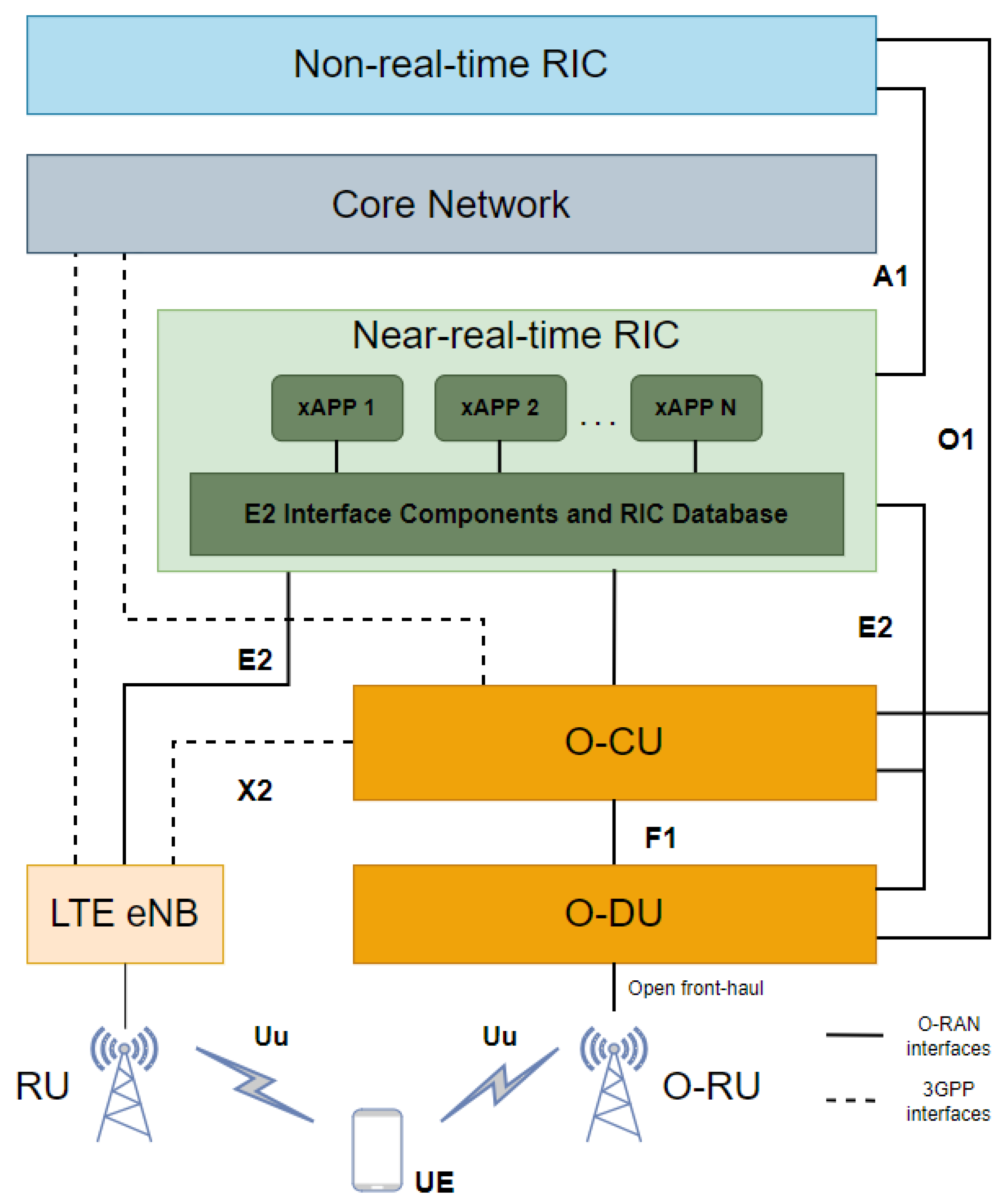


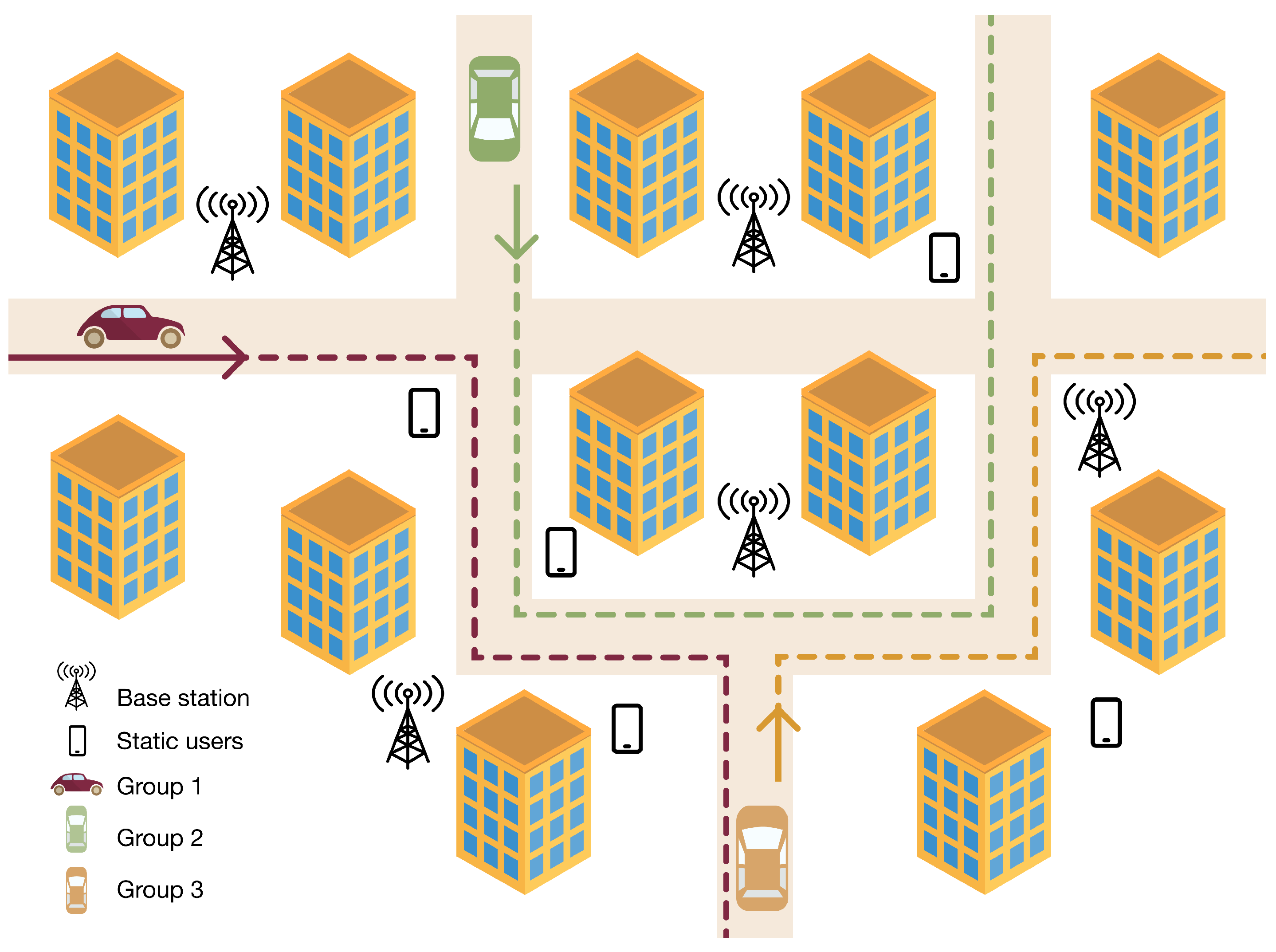
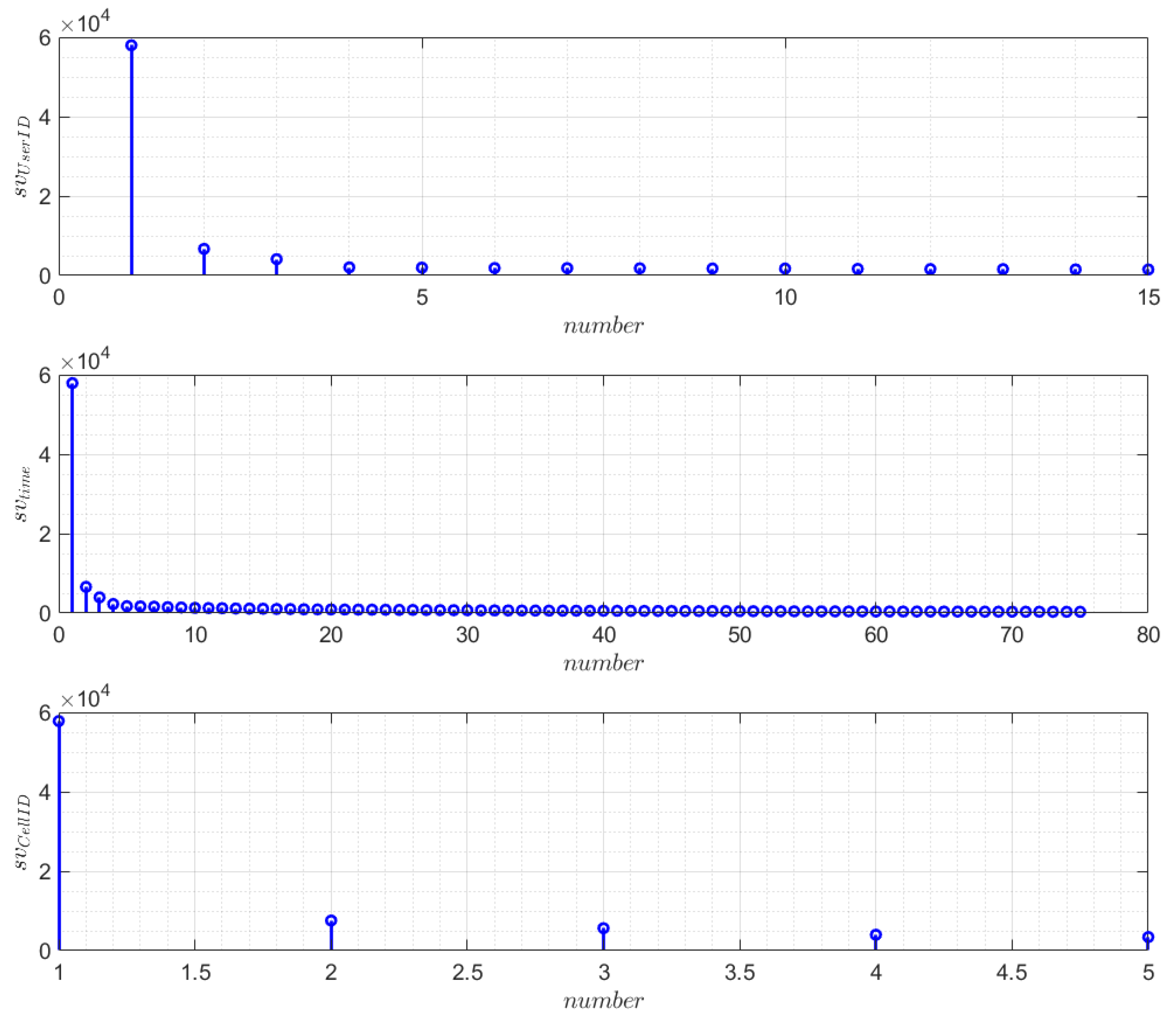

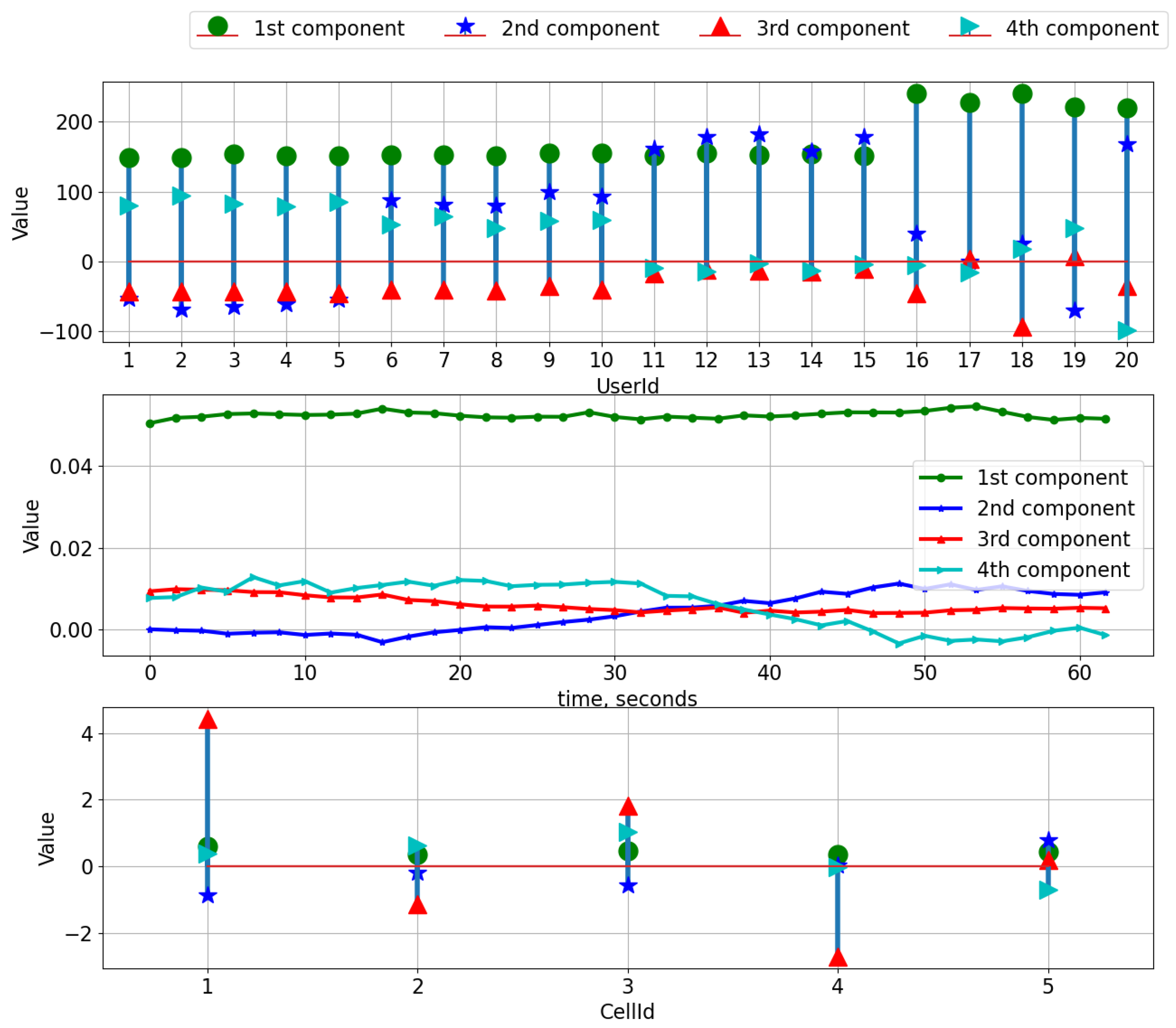
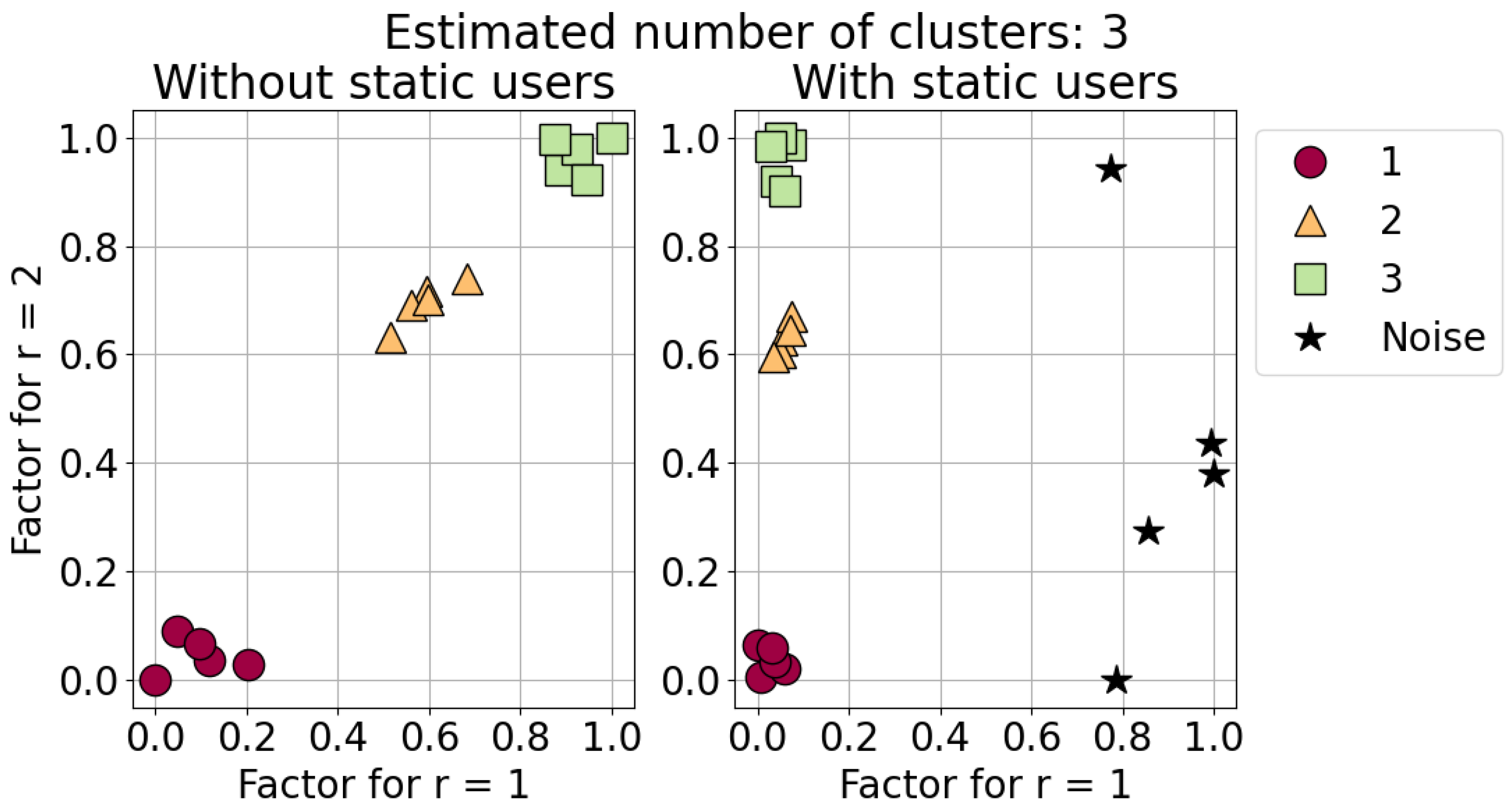
Disclaimer/Publisher’s Note: The statements, opinions and data contained in all publications are solely those of the individual author(s) and contributor(s) and not of MDPI and/or the editor(s). MDPI and/or the editor(s) disclaim responsibility for any injury to people or property resulting from any ideas, methods, instructions or products referred to in the content. |
© 2023 by the authors. Licensee MDPI, Basel, Switzerland. This article is an open access article distributed under the terms and conditions of the Creative Commons Attribution (CC BY) license (https://creativecommons.org/licenses/by/4.0/).
Share and Cite
Ashaev, I.P.; Safiullin, I.A.; Gaysin, A.K.; Nadeev, A.F.; Korobkov, A.A. An Approach for Using a Tensor-Based Method for Mobility-User Pattern Determining. Inventions 2024, 9, 1. https://doi.org/10.3390/inventions9010001
Ashaev IP, Safiullin IA, Gaysin AK, Nadeev AF, Korobkov AA. An Approach for Using a Tensor-Based Method for Mobility-User Pattern Determining. Inventions. 2024; 9(1):1. https://doi.org/10.3390/inventions9010001
Chicago/Turabian StyleAshaev, Ivan P., Ildar A. Safiullin, Artur K. Gaysin, Adel F. Nadeev, and Alexey A. Korobkov. 2024. "An Approach for Using a Tensor-Based Method for Mobility-User Pattern Determining" Inventions 9, no. 1: 1. https://doi.org/10.3390/inventions9010001
APA StyleAshaev, I. P., Safiullin, I. A., Gaysin, A. K., Nadeev, A. F., & Korobkov, A. A. (2024). An Approach for Using a Tensor-Based Method for Mobility-User Pattern Determining. Inventions, 9(1), 1. https://doi.org/10.3390/inventions9010001





